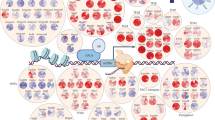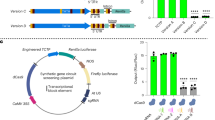Abstract
The analysis of gene regulation in bacteria is entering a new phase. Global regulatory networks, signal processing, responses of complexly regulated sets of genes, and interactions between regulatory systems are becoming a focus of intensive research efforts. Our understanding of how bacteria integrate diverse external and internal stimuli into a concerted cellular response may be the key to successfully engineer commercially important microbes, and treat medically significant bacteria. Research on Pseudomonas has contributed to the overall progress in this field.
This is a preview of subscription content, access via your institution
Access options
Subscribe to this journal
Receive 12 print issues and online access
$209.00 per year
only $17.42 per issue
Buy this article
- Purchase on Springer Link
- Instant access to full article PDF
Prices may be subject to local taxes which are calculated during checkout
Similar content being viewed by others
References
Palleroni, N.J. 1986. Taxonomy of pseudomonads. Vol. X, p3–25. In: The Bacteria. Sokatch, J.R. (Ed.) Academic Press, NY.
Lindow, S.E., Panopoulos, N.J., and McFarland, B.L. 1989. Genetic engineering of bacteria from managed and natural habitats. Science 244:1300–1307.
Iglewski, B.H. 1989. Probing Pseudomonas aeruginosa, an opportunistic pathogen. ASM News 55:303–307.
Crawford, I.P. 1988. The synthesis of tryptophan from chorismate: comparative aspects. Methods Enzymol. 142:293–300.
Ronson, C.W., Nixon, B.T., and Ausubel, F.M. 1987. Conserved domains in bacterial regulatory proteins that respond to environmental stimuli. Cell 49:579–581.
Henikoff, S., Haughn, G.W., Calvo, J.M., and Wallace, J.C. 1988. A large number of bacterial activator proteins. Proc. Natl. Acad. Sci. USA 85:6602–6606.
Cornelis, G., Sluiters, C. de Rouvroit, C.L. Michiels, T. 1989. Homology between VirF, the transcriptional activator of Yersinia virulence regulon, and AraC, the Escherichia coli arabinose operon regulator. J. Bacteriol. 171:254–262.
Henikoff, S., Wallace, J.C., and Brown, J.P. 1989. Finding protein similarities with nucleotide sequence databases. Methods Enzymol. In press.
Deretic, V., Dikshit, R., Konyecsni, W.M., Chakrabarty, A.M., and Misra, T.K. 1989. algR gene, which regulates mucoidy in Pseudomonas aeruginosa belongs to a class of environmentally responsive genes. J. Bacteriol. 171:1278–1283.
Inouye, S., Nakazawa, A., and Nakazawa, T. 1988. Nucleotide sequence of the regulatory gene xylR of the TOL plasmid from Pseudomonas putida. Gene 66:301–306.
Schell, M.A., and Sukordhaman, M. 1989. Evidence that the transcription activator encoded by the Pseudomonas putida nahR gene is evolutionarily related to the transcription activators encoded by the Rhizobium nodD genes. J. Bacteriol. 171:1952–1959.
Frantz, B., and Chakrabarty, A.M. 1987. Organization and nucleotide sequence determination of a gene cluster involved in 3-chlorocatechol degradation. Proc. Natl. Acad. Sci. USA 84:4460–4464.
Aldrich, T.L. and Chakrabarty, A.M. 1988. Transcriptional regulation, nucleotide sequence, and localization of the promoter of the catBC operon in Pseudomonas putida. J. Bacteriol. 170:1297–1304.
Chang, M., Hadero, A., and Crawford, I.P. 1989. Sequence of the Pseudomonas aeruginosa trpI activator gene and relatedness of trpI to other procaryotic regulatory genes. J. Bacteriol. 171:172–183.
Renault, P., Gaillardin, C., and Heslot, H. 1989. Product of the Lactococcus lactis gene required for malolactic fermentation is homologous to a family of positive regulators. J. Bacteriol. 171:3108–3114.
Ebright, R.H. 1986. Proposed amino acid-base pair contacts for 13 sequence-specific DNA binding proteins, p207–219. In: Protein structure, Folding and Design. Oxender, D. (Ed.). Alan Liss, New York.
Ishimoto, K.S., and Lory, S. 1989. Formation of pilin in Pseudomonas aeruginosa requires the alternative σ factor (RpoN) of RNA polymerase. Proc. Natl. Acad. Sci. USA 86:1954–1957.
Dixon, R. 1986. The xylABC promoter from the Pseudomonas putida TOL plasmid is activated by nitrogen regulatory genes in Escherichia coli. Mol. Gen. Genet. 203:129–136.
Grim, C. and Panopoulos, N.J. 1989. The predicted protein product of a pathogenicity locus from Pseudomonas syringae pv. phaseolicola is homologous to a highly conserved domain of several procaryotic regulatory proteins. J. Bacteriol. 171:5031–5038.
Huala, E. and Ausubel, F.M. 1989. The central domain of Rhizobium meliloti NifA is sufficient to activate transcription from the R. meliloti nifH promoter. J. Bacteriol. 171:3354–3365.
Popham, D.L., Szeto, D., Keener, J., and Kustu, S. 1989. Function of a bacterial activator protein that binds to transcriptional enhancers. Science 243:629–635.
Helmann, J.D. and Chamberlin, M.J. 1988. Structure and function of bacterial sigma factors. Ann. Rev. Biochem. 57:839–872.
Deretic, V., Konyecsni, W.M. 1989. Control of mucoidy in Pseudomonas aeruginosa: Transcriptional regulation of algR and identification of the second regulatory gene, algQ. J. Bacteriol. 171:3680–3688.
Itoh, Y., Soldati, L., Stalon, V., Falmagne, P., Terawaki, Y., Leisinger, T., and Haas, D. 1988. Anabolic ornithine carbamoyltransferase of Pseudomonas aeruginosa: Nucleotide sequence and transcriptional control of the argF structural gene. J. Bacteriol. 170:2725–2734.
Inouye, S., Nakazawa, A., and Nakazawa, T. 1985. Determination of the transcription initiation site and identification of the protein product of the regulatory gene xylR for xyl operons on the TOL plasmid. J. Bacteriol. 163:863–869.
Stock, A.M., Mottonen, J.M., Stock, J.B., and Schutt, C.E. 1989. Three-dimensional structure of Che Y, the response regulator of bacterial chemotaxis. Nature 337:745–749.
Ninfa, A.J. and Magasanik, B. 1986. Covalent modification of the glnG product, NRI by the glnL product, NRII, regulates the transcription of the glnALG operon in Escherichia coli. Proc. Natl. Acad. Sci. USA 83:5909–5913
Weiss, W. and Magasanik, B. 1988. Phosphorylation of nitrogen regulator I (NRI) of Escherichia coli. Proc. Natl. Acad. Sci. USA 85:8919–8923.
Igo, M.M., Ninfa, A.J., and Silhavy, T.J. 1989. A bacterial environmental sensor that functions as a protein kinase and stimulates transcriptional activation. Genes and Development 3:598–605.
Miller, J.F., Mekalanos, J.J., and Falkow, S. 1989. Coordinate regulation and sensory transduction in the control of bacterial virulence. Science 243:916–922.
Stock, J.B., Ninfa, A.J., and Stock, A.M. 1989. Protein phosphorylation and the regulation of adaptive responses in bacteria. Microbiol. Rev. In press.
Peng, H.L., Novick, R.P., Kreiswirth, B., Kornblum, J., and Schlievert, P. 1988. Cloning, characterization, and sequencing of an accessory gene regulator (agr)in Staphylococcus aureus. J. Bacteriol. 170:4365–4372.
Miller, V.L., DiRita, V.J., and Mekalanos, J.J. 1989. Identification of toxS, a regulatory gene whose product enhances ToxR-mediated activation of the cholera toxin promoter. J. Bacteriol. 171:1288–1293.
Proposed by the graduate students in the Department of Microbiology, UTHSC, San Antonio, during a journal club meeting.
Ninfa, A.J., Ninfa, E.G., Lupas, A.N., Stock, A., Magasanik, B., and Stock, J. 1988. Crosstalk between bacterial chemotaxis signal transduction proteins and regulators of transcription of the Ntr regulon: evidence that nitrogen assimilation and chemotaxis are controlled by a common phosphotransfer mechanism. Proc. Natl. Acad. Sci. USA 85:5492–5496.
Iuchi, S., Furlong, D., and Lin, E.C.C. 1989. Differentiation of arcA, arcB, and cpxA mutant phenotypes of Escherichia coli by sex pilus formation and enzyme regulation. J. Bacteriol. 171:2889–2893.
Matsuyama, S.I., Mizuno, T., and Mizushima, S. 1986. Interaction between two proteins in osmoregulatory expression of ompF and ompC genes in Escherichia coli: a novel ompR mutation suppresses pleiotropic defect caused by an envZ mutation. J. Bacteriol. 168:1309–1314.
Henner, D.J., Yang, M., and Ferrari, E. 1988. Localization of Bacillus subtilis sacU (Hy) mutations to two linked genes with similarities to the conserved procaryotic family of two-component signalling systems. J. Bacteriol. 170:5102–5109.
Darzins, A., Wang, S.K., Vanags, R.I., and Chakrabarty, A.M. 1985. Clustering of mutations affecting alginic acid biosynthesis in mucoid Pseudomonas aeruginosa. J. Bacteriol. 164:516–524.
Darzins, A., Nixon, L.L., Vanags, R.I., and Chakrabarty, A.M. 1985. Cloning of Escherichia coli, and Pseudomonas aeruginosa phosphomannose isomerase genes and their expression in alginate-negative mutants of Pseudomonas aeruginosa. J. Bacteriol. 161:249–257.
Deretic, V., Gill, J.F., and Chakrabarty, A.M. 1987. Gene algD coding for GDPrnannose dehydrogenase is transcriptionally activated in mu-coid Pseudomonas aeruginosa. J. Bacteriol. 169:351–358.
Deretic, V., Gill, J.F., and Chakrabarty, A.M. 1987. Alginate Biosynthesis: A model system for gene regulation and function in Pseudomonas. Nature Biotechnology 5:469–477.
Fyfe, J.A.M. and Govan, J.R.W. 1980. Alginate synthesis in mucoid Pseudomonas aeruginosa: a chromosomal locus involved in control. J. Gen. Microbiol. 119:443–450.
MacGeorge, J., Korolik, V., Morgan, A.F., Ashce, V., and Holoway, B.W. 1986. Transfer of a chromosomal locus responsible for mucoid colony morphology in Pseudomonas aeruginosa isolated from cystic librosis patients to P. aeruginosa PAO. J. Med. Microbiol. 21:331–336.
Flynn, J.L. and Ohman, D.E. 1988. Use of gene replacement cosmid vector for cloning alginate conversion genes from mucoid and non-mucoid Pseudomonas aeruginosa strains: algS controls expression of algT. J. Bacteriol. 170:3228–3236.
Govan, J.R.W., Fyfe, J.A.M., and Baker, N.R. 1983. Hetergeneity and reduction in pulmonary clearance of mucoid Pseudomonas aeruginosa. Rev. Infect. Dis. 5:S874–S879.
Berry, A., De Vault, J.D., and Chakrabarty, A.M. 1989. High osmolarity is a signal for enhanced algD transcription in mucoid and nonmucoid Pseudomonas aeruginosa strains. J. Bacteriol. 171:2312–2317.
Govan, J.R.W., Fyfe, J.A.M., and McMillan, C. 1979. The instability of mucoid Pseudomonas aeruginosa: Fluctuation test and improved stability of the mucoid form in shaken culture. J. Gen. Microbiol. 110:229–233.
Wanner, B.L., Wilmes, M.R., and Young, D.C. 1988. Control of bacterial alkaline phosphatase synthesis and variation in an Escherichia coli K-12 phoR mutant by adenyl cyclase, the cyclic AMP receptor protein, and the phoM operon. J. Bacteriol. 170:1092–1102.
Seifert, H.S., and So, M. 1988. Genetic mechanisms of bacterial antigenic variation. Microbiol. Rev. 52:327–336.
Iuchi, S., and Lin, E.C.C. 1988. arcA (dye), a global regulatory gene in Escherichia coli mediating repression of enzymes in aerobic pathways. Proc. Natl. Acad. Sci. USA 85:1888–1892.
Weston, L.A. and Kadner, R.J. 1988. Role of uhp genes in expression of the Escherichia coli sugar-phosphate transport system. J. Bacteriol. 170:3375–3383.
David, M., Daveran, M.L., Batut, J., Dedieu, A., Domergue, O., Ghai, J., Hertig, C., Biostard, P., and Kahn, D. 1988. Cascade regulation of nifgene expression in Rhizobium meliloti. Cell 54:671–683.
Stewart, V., Parales, J., Jr., and Merkel, S.M. 1989. Structure of genes narL and narX of the nar (nitrate reductase)locus in Escherichia coli K-12. J. Bacteriol. 171:2229–2234.
Wozniak, D.J., Cram, D.C. Daniels, C.J., and Galloway, D.R. 1987. Nucleotide sequence and characterization of toxR: a gene involved in exotoxin A regulation in Pseudomonas aeruginosa. Nucleic Acids Res. 15:2123–2135.
Duchene, M., Schweizer, A., Lottspeich, F., Krauss, G., Marget, M., Vogel, K. von Specht, B.U., and Domdey, H. 1988. Sequence and transcriptional start site of the Pseudomonas aeruginosa outer membrane porin protein F. gene. J. Bacteriol. 170:155–162.
O'Hoy, K. and Krishnapillai, V. 1987. Recalibration of the Pseudomonas aeruginosa strain PAO chromosomal map in time units using high-frequency-of-recombination donors. Genetics 115:611–618.
Author information
Authors and Affiliations
Rights and permissions
About this article
Cite this article
Deretic, V., Konyecsni, W., Mohr, C. et al. Common Denominators of Promoter Control in Pseudomonas and Other Bacteria. Nat Biotechnol 7, 1249–1254 (1989). https://doi.org/10.1038/nbt1289-1249
Issue Date:
DOI: https://doi.org/10.1038/nbt1289-1249
This article is cited by
-
Genetics of methane and methanol oxidation in Gram-negative methylotrophic bacteria
Antonie van Leeuwenhoek (1994)
-
New organisms—novel genetics
World Journal of Microbiology & Biotechnology (1992)



